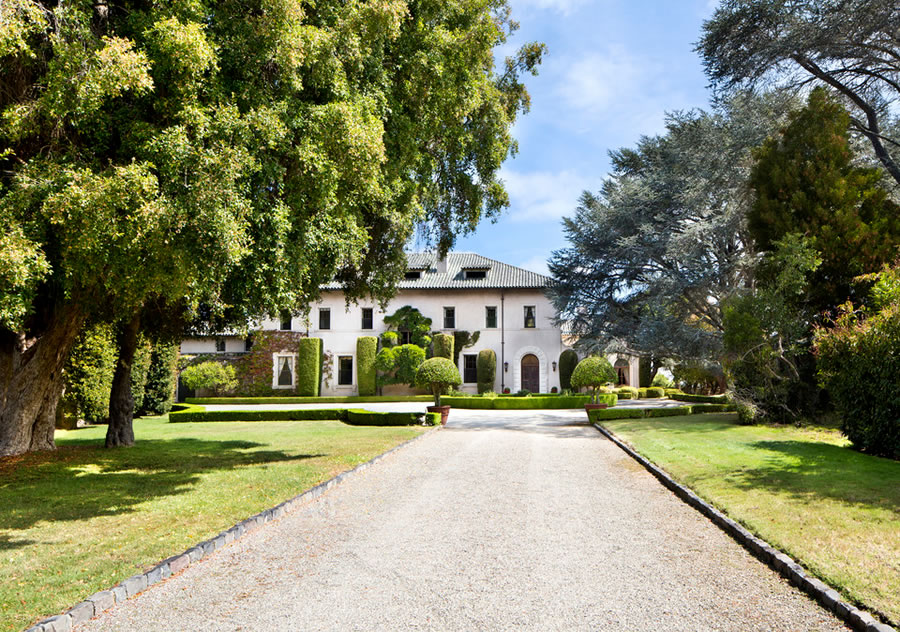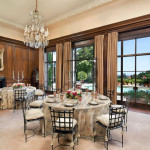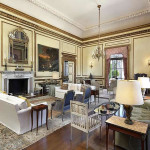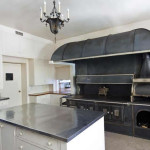On the market for $100 million in 2013, the asking price for the 47.5-acre de Guigne estate at 891 Crystal Springs Road in Hillsborough, which includes a classic 16,000-square-foot mansion, was dropped to $39.9 million in 2015 and the condition that the buyer grant the seller, Christian de Guigne IV, a life estate in the property, maintaining his exclusive use of the estate until he passes, was dropped as well.
Early last year, the list price for the estate was reduced to $34.9 million, a price which was reduced another 14.5 percent to $29.85 million seven months ago.
And the sale of the estate and mansion (which was designed by Bliss & Faville, built for the de Guigné family in 1912 and last renovated by Anthony Hail in the 1960s) has now closed escrow at $29.85 million, which is officially “at asking” according to all MLS-based stats.
A proposal by Mr. de Guigne to subdivide the estate, which is one of the largest privately owned parcels on the San Francisco Peninsula, and build 25 new homes upon the property (versus 10 as the town’s general plan would appear to principally allow) was floated in 2009 but never came to fruition. We’ll keep you posted and plugged-in.
UPDATE (6/23): Make That 23 Percent of Original Asking for This Silicon Valley Estate.





I just gotta challenge the Silicon Valley label for Hillsborough. I realize there is a lot of tech located on the peninsula these days, but Silicon Valley is referring to the valley that is south of the peninsula. I would argue that the farthest northern city that could be legitimately described as being Silicon Valley is Redwood City- mostly because of the Redwood Shores area which is home to Oracle and other tech campuses there on the Flat bay front that extends south. Maybe Foster City… but even that area feels to far north to me to be characterized as Silicon Valley.
The entire Bay Area is Silicon Valley.
Hillbillyboroughville is not now nor will ever be, in the Bay Area or Silicon Valley. HByville exists on its own plane, hoovering somewhere between David Lynchburg and Bowie Town.
“Silicon Valley” started out in Palo Alto and was primarily in San Mateo County in the beginning (late 50s- early 60s). That’s where Schokley’s lab was and then the traitorous 8 went to work for Fairchild Semiconductor, in Sunnyvale. It then spread South reaching San Jose in the late 80s/early 90s, and North, reaching San Francisco in the late 90s/early 00s (with the .com bubble, a phenomenon in which San Francisco very clearly participated in).
You can still find people who swear that the southern-most part of Silicon Valley is Santa Clara (City, not county) — home of Applied Materials, founded in the late 60s), and that it really shouldn’t include San Jose. If you come back and say that Adobe is headquartered there as well as other companies, they’ll point out that these are transplants having been founded further to the north — and they are right! Of course these people probably also swear that it shouldn’t go farther up than Redwood City, and really menlo park.
I think we lack a council of 40 tech immortals to adjudicate this, but I have noticed that the age of the speaker plays a role in how they define the boundaries of Silicon Valley.
Except that PA is in Santa Clara County, not San Mateo, so if it “started out” there, when did it become “primarily in” the latter. And of course HP – which might be named as a founding force – also got its start in PA…so at least two decades in SC before SM enters the scene.
Yes, you are right! In terms of counties, it started in Santa Clara first. Although, to be fair, Palo Alto is right on the border. But the point being it started well north of San Jose, and came to San Jose much later.
the entire peninsula is silicon valley.
Would you include city of SF?
No, it’s not.
Seconded, if your municipality never had a “fab”, you’re not Silicon Valley. If your municipality never had glass blowers employed within it’s boundaries, you weren’t Vacuum Tube Valley before Silicon Valley.
Menlo Park, Palo Alto never had a Fab.
Well, it’s quite the estate. Congrats to the new owner.
Pacifica Quarry property is 86 acres. I believe that is the largest privately owned parcel in San Mateo County.
The place obiously needs open floor plan, one or more of those floating gas fireplaces, all marble kitchen with a pot filler, and tons of can down lights everywhere. Just a little updating for the flip.
Spot on! That and painting all of the walls white. Basically eliminating the character from the home.
I must say the current interior decoration is not really to my taste, however. Nothing another million dollars couldn’t fix.
It will be interesting to see whether the buyer retains this as one large parcel or does the ten-way split as the city allows. A back of the envelope calculation shows that the ten way split should be profitable even by just developing the roads and utilities and selling the parcels without building.
Transfer tax indicates a price of $23,364,000. Would you say where you heard $29.85 million?
It would appear as though we’ve been snookered by the MLS (for which we’ll soon make amends).
Maybe I missed it, but the seller’s age is certainly of relevance to the story, no?
He’s 79. Statistically he has about eight years left in him.
You have to allow for the fact that rich people tend to live longer than average. it’s admittedly an anecdote, but when Hugh Hefner put the Playboy mansion up for sale, he also attached a life estate in/to the property. Hefner was 89 years old at the time. The mansion sold for $100 million last year. Hefner is still alive.
No. As noted in our first paragraph above, “the [original] condition that the buyer grant the seller, Christian de Guigne IV, a life estate in the property, maintaining his exclusive use of the estate until he passes, was dropped as well.”
Perhaps “Orland” was implying that the (some people might say) elderly age of the individual influenced both (1) the setting of an (apparently) unrealistic initial price, and/or (2) a final acceptance of much less due to a desire to finally close the sale…w/i his lifetime.
Of course the first argument would seem to be negated by the fact that the seller was less elderly two years ago, and presumably would have become more, not less, irrational as time went on.
The money was in San Mateo County (Sand Hill) and the worker bees/brains in Santa Clara (Page Mill). The nexus in between is Stanford which has always been the center of Silicon Valley. Everything else is shifting sands.
UPDATE: Make That 23 Percent of Original Asking for This Silicon Valley Estate